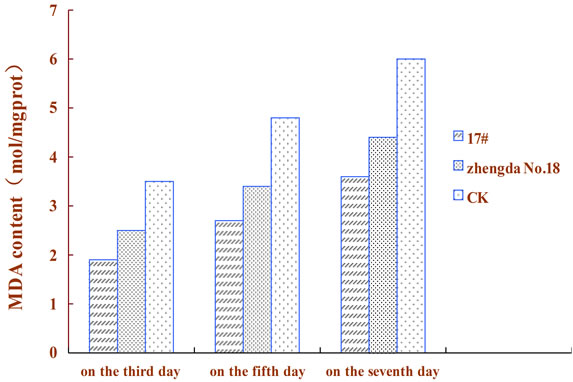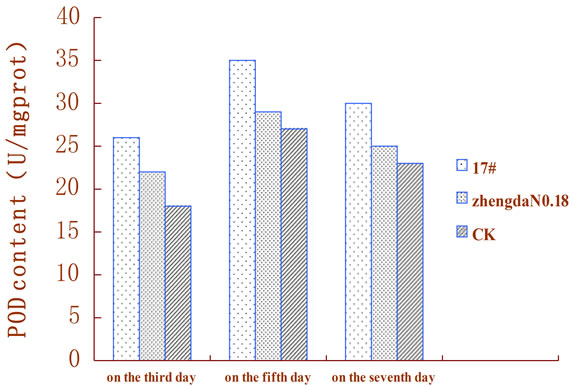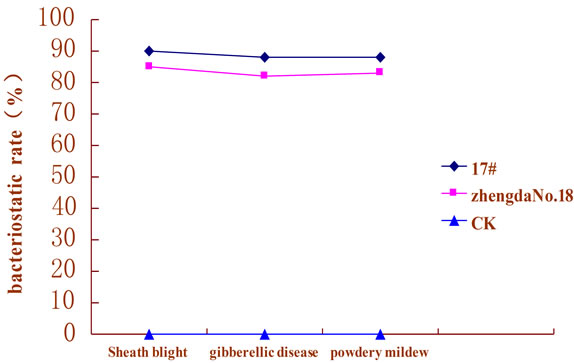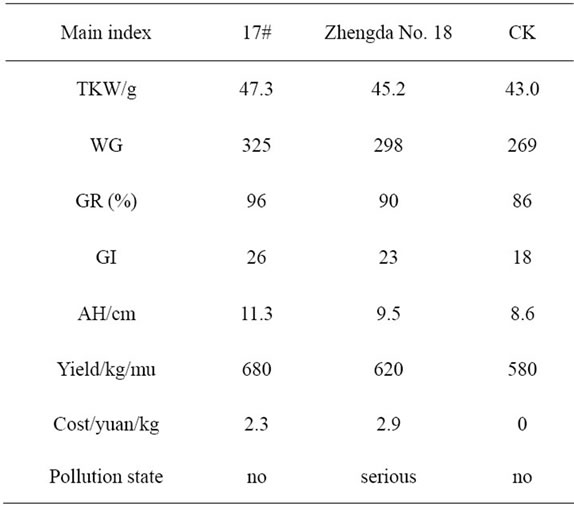Agricultural Sciences
Vol.4 No.7(2013), Article ID:33863,6 pages DOI:10.4236/as.2013.47048
Activity test and mechanism study of an environmentally friendly wheat seed coating agent
![]()
School of Resource and Environmental Engineering, Wuhan University of Technology, Wuhan, China; 1402254045@qq.com
Copyright © 2013 Defang Zeng, Huifang Zhao. This is an open access article distributed under the Creative Commons Attribution License, which permits unrestricted use, distribution, and reproduction in any medium, provided the original work is properly cited.
Received 26 May 2013; revised 17 June 2013; accepted 25 June 2013
Keywords: Wheat Seed Coating Agent; Increase Wheat Yield; Environmentally Friendly; MDA; POD
ABSTRACT
This novel environmentally friendly wheat seed coating agent which has been made with natural polymer as the primary material could increase yield by about 9% compared with the conventionally virulent wheat seed coating agent. In the premise of this production, the content of malondialdehyde (MDA) and peroxidase (POD) was determined. The results show that, after treated by the self-made wheat seed coating agent, the contents of the MDA were less than traditional group and the blank control group and POD contents were higher than traditional group and blank control group, this provides a good foundation on the further research of self-control wheat seed coating agent.
1. INTRODUCTION
China is a large agricultural nation, so how to improve the food production has always been the center of our topic, but environmental pollution problems by the pesticide have been with us [1-6]. With the development of the seed coating technology, more and more seeds were treated with seeds coating agent before sowed. It can improve the quality of seed germs and save seeds at the same time. Wheat seeds coating agent contains many trace elements such as Mn, Zn, B and so on, it can effectively prevent the crop nutrient deficiency, increase production, promote germinate and stimulate plant growth.
Although the traditional wheat seed coating agent also could improve the crop production, however, the effective components in the traditional contain a lot of poisonous and harmful ingredients, such as thiram, carbofuran, three silicone and so on. So the pollution and harm to our environment from this also cannot be ignored. How to improve crop production and reduce the pollution caused by pesticides at the same time has become an urgent problem to be solved [7-11].
This study was started from the premise and the purpose that this pesticide could reduce the pollution of the environment and improve the wheat yield. A kind of novel wheat seed coating agent was developed in which a natural polymer polysaccharide as the main composition, adds wheat essential trace elements and auxiliary agents. It indicated that it arrived the basic requirements that it must be environment friendly and pollution-free, and it also can improve the wheat yield 8% - 10% or so compared with the traditional pesticide, so it is a kind of novel wheat seed coating agent which was worthy of promotion.
2. MATERIALS AND REAGENTS
Traditional wheat seed coating agents were zhengda No. 18 (which were obtained from Zhongzhou Agricultural Seed Company in Henan, P.R. China), polysaccharide (PO, made in lab), biological bacteriostatic agent (BT, made in lab), Rhizoctonia cerealis (agriculture science and technology academy test site in Henan), deionized water for laboratory, violet natural pigment (German Food Additives, Ltd., Shantou, Guangdong, China), sand, agar medium (WeiDa chemical Co., Ltd. in Guangzhou ), cane sugar (Nan Ning cane sugar crop in Guangxi), potatos (Hong’an, Hubei), Wheat seeds (Yufeng, wheat seeds company, Henan, China).
3. EXPERIMENT PROCESS
3.1. The Test on Germination Potential and Germinate Rate
The test steps about wheat germination potential and germination rate were as follows: take a certain amount of wheat seeds with electronic scale and then coated with the self-made wheat seed coating agent (marked 17 #) according to 1:50 proportion, some others were treated with the traditional pesticide (zhengda No. 18) according to the specifications, Mix well, put them in room temperature 20 minutes or so, divided into four groups and each group take 100 seeds, germination bed for double wet filter paper, and then put them in the constant temperature and humidity incubator culture with temperature for (25 ± l)˚C, and humidity for 70%, the phenomenon, seed germination potential, germination rate, germination index must be recorded (seed germination potential was recorded on the 4th day, seed germination rate recorded on the 7th day). Then twenty of the wheat seed germs were chosen in each group randomly and the height and root length would be measured, each make four repeat, experimental data for its average. The computation formula is as follows:



where Gf is the number of germinated seeds on the 4th day, Gs is the number of germinated seeds on the 7th day, Gt is the total number of seeds, Gn is the daily germination numbers, Gd is the corresponding germination days.
3.2. Determine the Content of MDA in the Wheat Germs
Malondialdehyde (MDA) is the product of cell membrane lipid peroxidation, which can increase the degree of cell membrane damage. The quantity of MDA can reflect the antioxidant ability is strong or weak in the plant cell organization indirectly and it also can be in a certain extent represent the degree of peroxidation, so the content of MDA is a very important index in the study of plant senescence physiological and resistance physiological [12-18]. From the above three groups of wheat seedings, take 4 plants growing similar wheat seedings, shredded the wheat seedling leaves and take 1 g in a beaker, then add 10% trichloroacetic acid 2 ml and small amounts of quartz sand in it. Grinding the seedings to slurry, centrifugal about 10 minutes. Absorb supernatant 2 ml, add 2 ml 0.6% sulfur generation barbituric acid solution, mix well before in a boiling water bath reaction 15 min, centrifugal about 10 minutes after the rapid cooling, take supernatant fluid and determine the absorbance under the wavelength of 532 nm, 600 nm and 450 nm respectively, then calculate the content of MDA. The computation formula is as follows:

3.3. Determine the Content of POD in the Wheat Germs
The activity of peroxidase (POD) was measured by guaiacol colorimetric method: 1) enzyme liquid extraction. Take 0.5 g sheared wheat seedling leaves, add 2 ml phosphate buffer which pH = 7 in the mortar and grind into slurry. All of the slurry was poured into a centrifuge tube, centrifugal 10 min under 3000 rpm, and then transfer supernatant fluid into volumetric flask with the volume 25 ml. Precipitation was washed with 5 ml phosphate buffer two times, supernatant fluid join volumetric flask of constant volume to scale, low temperature preservation standby; 2) the enzyme determination: add in 2.9 ml 0.05 mol·l−1 phosphate buffer, 1.0 ml 2% H2O2, 1.0 ml 0.05 mol·l−1 guaiacol and 0.1 ml enzyme solution in order. With heating boiling 5 minutes of enzyme solution for comparison, pour enzyme solution into reaction system, then put it into water bath with the temperature 30˚C immediately with 3 minutes, and then dilution it 1 times quickly. Record the absorbance in 470 nm wavelength every 1 minutes, marked A470, a total of five times, A470 changed 0.01 in per minute was called one enzyme activity unit (U).

where D for dilution multiple extraction is the total enzyme solution for reaction system in enzyme liquid ratio; T for the reaction time.
3.4. Antibacterial Experiment on Wheat Seed Coating Agents
The antibacterial experiment included two aspects: the fungus vaccinations and the colony diameter measurement. Make a culture medium with sugar, potatoes, AGAR and other materials for fungus to growth, then the blight fungus was vaccinated in the culture medium, and then add to the wheat seed coating agent which made in lab and traditional pesticide separately, all the vessels are treated under the high pressure, the antibacterial effect was determined through the colony diameter. After the cultivation of 72 hours, remove the petri dish and observed the phenomenon with microscope. Then measure the colony diameter vernier calipers with cross measuring method 2 times (take the average), repeat 4 times and take the average, the bacteriostatic rate calculation formula is as follows:

where Fc is the presence of fungi on the control, Ft is the presence of fungi on the treated Petri dishes.
3.5. Field Trials
The wheat seeds were coated with the wheat seed coating agent make in lab (17 #) and the traditional (zhengda No. 18) respectively and sowed in wheat testing field for year-on-year test. Sowing in June and harvesting in October, the wheats were treated with the same field management during the time. The wheat germination rate and germination index were determined in wheat growth period and wheat plant height was determined after they were sown 30 days. When the wheats were harvested, the different index was recorded.
All the data were processed by excel and SPSS.
4. RESULTS AND DISCUSSION
4.1. The Effects of Different Kinds of Seed Coating Agent on Wheat Growth
It can be seen from Table 1 that, the wheats coated with17 # germination potential was 90%, it was 7% higher than the traditional and 12% higher than blank CK, the germination rate were increased by 9% and 17% respectively, germination index increased by 3 and 8 respectively. By measuring the first ten days of plant height and average root length, the height coated with17 # was 10.3 cm, it was 0.3 cm higher than the traditional and 1.7 cm higher than CK, the average root length was 3.7 cm, it was also increased. In the experiment it can be observed that the wheat coated with 17 # was stronger and the roots of the wheat seeding growth robust compared with the traditional pesticide and blank CK. It can be seen from above that the novel wheat seed coating agent can promote the wheat germination potential and the wheat germination rate effectively and can continuous control the growth of wheat and the control effect is superior to the traditional.
4.2. The Effects of Different Kinds of Seed Coating Agent on MDA Content
The content of MDA represents the degree of membrane lipid peroxidation to some extent. Its content can indirectly reflect the plant cell organization of antioxidant ability, the content of MDA lower, the plant antioxidant ability stronger. It can be seen from the Figure 1 that through the measurement of MDA content in the third day, the fifth day, the seventh day respectively, the MDA content in wheat germ coated by 17 # was lower than any other two. In addition, MDA content in these three days with the same kind of seed coating agent was analyzed respectively, MDA content in the wheat seedling coated with 17 # were increased by 0.8 and 0.9 respectively, while zhengda No. 18 increase by 0.9 and 1.2 respectively and CK was increased of 1.3 and 1.2 respectively. These date show that 17 # can prevent the increase of MDA better in wheat germs. To sum up, 17 # could reduce the content of MDA in wheat germ effectively, and can restrain the MDA increases continuously in the later, so 17 # could increase the wheat antioxidant ability and improve the ability of the wheat disease resistance, finally the overall yield of wheats have been promoted.
4.3. The Effects of Different Kinds of Seed Coating Agent on POD Content
Peroxidase plays an important role on plant growth and development. Peroxidase content will increased in plant when plant suffer from adversity conditions, this shows that in wheat germs, the peroxidase content higher, the plant resistance stronger. The content of POD was determined on the third day, the fifth day and the seventh day respectively, the result (Figure 2) show that the POD content in the wheat germs coated with 17 # was the highest. From what has been discussed above, the wheat coated with 17 # was better than the other, the POD content in embryo are higher than the traditional and the blank group, this helps wheat better against the bad environment and increase the wheat resistance which is conducive to the growth of wheat and the increase of wheat production.
4.4. The Effects of Different Kinds of Seed Coating Agent on Bacteriostatic Rate
Sheath blight, gibberellic disease and powdery mildew were chosen in this study, it can be seen from the Figure 3 that the antibacterial effect of this novel wheat seed coating agent to these three kinds of diseases is very small, the antibacterial rate is 90%, 88% and 88% re-

Table 1. The effects of different kinds of seed coating agent on wheat growth.

Figure 1. The effects of different kinds of seed coating agent on MDA content.

Figure 2. The effects of different kinds of seed coating agent on POD content.
pectively. But generally speaking, antibacterial rate of 17 # is always better than the traditional and CK. In conclusion: the novel wheat seed coating agent 17 # has a very good antibacterial effect compared with the traditional. The traditional pesticide is usually contain many kinds of poison chemical materials which could kill the pests and bacteria, while This novel wheat seed coating agent has been made with natural polymer as the primary material, so it can protect the wheat seeds from the violated effectively and it’s very friendly to our environment.
4.5. The Results of Experiments in the Field
Where the TKW is thousand kernel weight, WG is the total number of wheat grain of ten wheats, GR is germination rate, GI is germination index, AH is the seedling average plant height after sowed 30 days.
From Table 2 we can see that the cost dropped about 21% compared with the traditional, the 17 # of germination rate was 6% higher than the traditional and 10% higher than the blank; Germination index was increased three compared with the traditional and improved by

Figure 3. The effects of different kinds of seed coating agent on bacteriostatic rate.

Table 2. The results of experiments in the field.
eight compared with the blank; After sowed 30 days, the seedling average plant height was measured, the result show that average height coated with 17 # was more than 1.8 cm higher than the traditional and about 2.7 cm higher than the blank. Wheat grain has also improved. The Wheat yield increased by about 9.7% compared with the traditional and increased by about 17.2% compared with the blank. From the above we can also know that the traditional pesticide could bring environmental pollution seriously, while the 17 # made in lab belong to a kind of environmental friendly seed coating agent with a wide range of application value.
5. DISCUSSION
The main component of 17 # is a natural polymer polysaccharide, it has obvious physiological regulating function on the plants, its specific regulating function is embodied in the following respects:
It could control of the enzyme activity in plants effectively. Peroxidase widely exists in plant tissue which can protect plants from poisoning. It plays an important role on the resistance of the plant. The activity of enzymes could be improved and the enzyme peak that could be advanced after the wheat seeds were coated, especially the activity of peroxidase improved obviously. On the other hand, the natural polymer polysaccharide can control endogenous hormone level and it can improve the seedling radical scavenging related enzyme activity and the content of radical scavenger, so it reduce the membrane lipid peroxidation of wheat seedlings effectively, thus promoted the root growth and seedling strong growth. The wheats treated with this novel seed coating agent can improve seedling peroxidase activity and reduce the content of MDA at the same time, It can promote the metabolism of the wheats and increased the seed germination rate and germination index through the role of the enzyme.
It could induce wheat produce resistance and increase wheat production. After the wheat seeds were inducted by chitosan, it can produce a new synthetic substances in wheat germ cell rapidly such as antitoxin and other materials which can stable the cell membrane structure and promote wheat normal physiological metabolism under the harsh environment condition. Moreover, this kind of natural polymer polysaccharide formed a layer of film which protect the seed itself from the soil harmful organisms violations, it can also improve the microcirculation around the seeds and make it more conducive to the growth of seedlings, so the wheat yield was increased effectively.
To sum up, the natural polymer polysaccharide in the seeds coating agent could affect enzyme levels in wheat germ: it could reduce the malondialdehyde content and increase peroxidase content, so it enhances the resistance of wheat finally. Moreover, it increases the ability of the wheat to absorb nutrients and can induce wheat to produce resistance for the bad environment. At the end, it makes the wheats have strong adaptability and promote the wheat production significantly.
6. CONCLUSION
This study is about the determination of wheat seedling germination rate and enzyme activity parameters after the wheats were coated with different kinds of wheat seed coating agent. The results show that the 17 # made in lab can improve the wheat germination rate effectively, it can promote the growth of wheat root system, increase the content of wheat seedling POD effectively and reduce the content of MDA at the same time. Moreover, it can improve the wheat germ resistance ability significantly, so it could ensure the wheat seedling strong growth. Field test further shows that it costs lower than the traditional and can improve the wheat production by about 9%. The most important is that it is an environmentally friendly wheat seed coating agent which deserved to be widely applied in agriculture.
![]()
![]()
REFERENCES
- Brooker, N.L., Lagalle, C.D., Zlatanic, A., Javni, I. and Petrovic, Z. (2007) Soy polyol formulations as novel seed treatments for the management of soil-borne diseases of soybean. Communications in Agricultural and Applied Biological Sciences, 72, 35-43.
- Bautista-Banos, S., Hernandez-Lopez, M., Bosquez-Molina, E. and Wilson, C.L. (2003) Effects of chitosan and plant extracts on growth of Colletotrichum gloeosporioides, anthracnose levels and quality of papaya fruit. Crop Protection, 22, 1087-1092.
- Ait Barka, E., Eullaffroy, P., Clement, C. and Vernet, G. (2004) Chitosan improves development, and protects Vitis vinifera L. against Botrytis cinerea. Plant Cell Reports, 22, 608-614. doi:10.1007/s00299-003-0733-3
- Enayat, A.O., Hanan F.A. and Somaia A.N. (2012) Chitosan induced hepatonephro toxicity in mice with special reference to gender effect in glycolytic enzymes activities. Regulatory Toxicology and Pharmacology, 62, 29- 40. doi:10.1016/j.yrtph.2011.11.010
- Li, Y.Y., Guo, X.L., Lin, P.F., et al. (2010) Preparation and functional properties of blend films of gliadins and chitosan. Carbohydrate Polymers, 81, 484-490. doi:10.1016/j.carbpol.2010.03.005
- Guo, Z., Chen, R., Xing, R., Liu, S., Yu, H., Wang, P., et al. (2006) Novel derivatives of chitosan and their antifungal activities in vitro. Carbo-Hydrate Research, 341, 351-354. doi:10.1016/j.carres.2005.11.002
- Meng, X.H., Yang, L.G., John, F., et al. (2010) Effects of chitosan and oligochitosan on growth of two fungal pathogens and physiological properties in pear fruit. Carbohydrate Polymers, 81, 70-75. doi:10.1016/j.carbpol.2010.01.057
- Rinaudo, M. (2006) Chitin and chitosan: Properties and applications. Progress in Polymer Science, 31, 603-632. doi:10.1016/j.progpolymsci.2006.06.001
- Seyed, M.O., Masoud, R., Seyed, H.R., et al. (2010) Development and evaluation of a novel biodegradable film made from chitosan and cinnamon essential oil with low affinity toward water. Food Chemistry, 122, 161-166. doi:10.1016/j.foodchem.2010.02.033
- Wang, Y.Q., Wang, X.L., Shan, Y.H., et al. (2010) Membrane-potential alteration during K+ uptake of different salt-tolerant wheat varieties. Agricultural Sciences in China, 9, 974-979. doi:10.1016/S1671-2927(09)60179-6
- Ma, P.P. and He, L.Q. (2001) Progress of chitosan in suppression of plant diseases. Natural Product Research and Development, 13, 82-86.
- Zhao, X.M., She, X.P., Du, Y.G., et al. (2007) Induction of antiviral resistance and stimulary efect by oligochitosan in tobacco. Journal of Pesticide Biochemistry and Physiology, 87, 78-84.
- Ziani, K., Ursúa, B. and Maté, J.I. (2010) Application of bioactive coatings based on chitosan for artichoke seed protection. Crop Protection, 29, 853-859. doi:10.1016/j.cropro.2010.03.002
- Chatterjee, S., Chatterjee, B.P. and Guha, A.K. (2008) Enhancement of growth and chitosan production by Rhizopus oryzae in whey medium by plant growth hormones. International Journal of Biological Macromolecules, 42, 120-126. doi:10.1016/j.ijbiomac.2007.10.006
- Li, J. and Zivanovic, S. (2010) Characterization and comparison of chitosan/PVP and chitosan/PEO blend films. Carbo-Hydrate Polymers, 79, 786-791. doi:10.1016/j.carbpol.2009.09.028
- Sanpui, P., Murugadoss, A., Durga Prasad, P.V., Ghosh, S.S. and Chattopadhyay, A. (2008) The antibacterial properties of a novel chitosan-Ag-nanoparticle composite. International Journal of Food Microbiology, 124, 142- 146. doi:10.1016/j.ijfoodmicro.2008.03.004
- Xia, W.S., Liu, P., Zhang, J.L. and Chen, J. (2011) Biological activities of chitosan and Chitooligos accharides. Food Hydrocolloids, 25,170-179. doi:10.1016/j.foodhyd.2010.03.003
- Xie, H.L. and Xu, G.M. (2008) Suspension property of gemini surfactant in seed coating agent. Journal of Dispersion Science and Technology, 29, 496-501. doi:10.1080/01932690701728684

